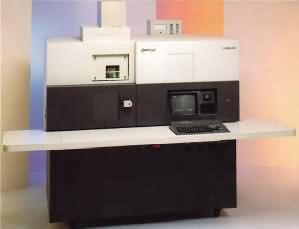|
Instrument Database:
Allied Analytical Systems - Plasma 300 - ICP-OES Spectrometer
( Thermo Scientific )
| |
|

|
| |
|
| |
|
| Year of introduction |
1985 |
| Status |
historical ( out of service ) |
| Company |
Allied Analytical Systems
|
| Categories |
Spectrometer ( Atom. ): AES: ICP-AES
|
|
The Plasma 300 ICP spectrometer from Allied Analytical Systems ofters a high degree of computer-controlled automation. The system's built-in microprocessor
controls the entire operation of the instrument, including the basic routine tasks which would otherwise demand much of your time but little of your true analytical skills. With full computer control, the analytical conditions of the Plasma 300 spectrometer are remarkably consistent from one operator to another, from one shift to the next. Among the functions under automated computer control are:
- plasma ignition/shutdown via simple, two-touch keyboard control for fast, uncomplicated, and error free operation
- plasma power level allowing day-to-day power reproducibility without operator adjustments
- plasma gas flows for operator-independent reproducibility, and protection against accidental torch meltdowns.
- sampie delivery and washout through a compact, built-in peristaltic pump, providing improved accuracy by precisely timing sample equilibration time and controlling sample uptake rate.
- optical systems including wavelength calibration, rapid wavelength scanning, variable observation height, analyte peak location, and oft-peak background
correction. - detection and readout systems including algorithms for multi-point calibration, background correction, internal standard correction, and interfering element correction.
- safety interlocks for hazard-free operation, by monitoring RF anode curren!, argon pressure, cooling water flowrate, and cabinet panels and by shutting down if problems arise.
|
| Specifications |
|
Dimensions (w x d x h in cm)
| 208 x 102 x 160
| Weight (kg)
|
| Power
| 3 phase; 50/60 Hz; 200, 208, 380, or 415 V; 6500 W
nominal
| Spectrometer
| I: air path Ebert double monochromator (165/330 mm)
II: vacuum Ebert monochromator(330 mm)
| | Grating | I: 1200 lines/mm; blazed at 500 nm; automated change over from 1st to 2nd order at 365 nm II: 2400 lines/mm; blazed at 280 nm;
| Optics
| I: silica lenses and quartz-coated mirrors under computer control for adjustement of optimum observation height for each element (0-48 mm above load coil); II: calcium fluoride lens; manual tilt mechanism;
| | Wavelength range | 190-900 nm (air path) 160-500 nm (vaccum)
| Wavelength drive
| grating drive with reference through Hg-lamp; refractory plate drive for fine wavelength adjustement for exact peak positioning, background correction and side-line indexing
| | Resolution | I: 20 pm at second order; II: 10 pm at second order
| | Detector |
| Detection mode
| sequential (18 /24 elements/min for one/two channel systems); true simultaneous internal standardization with two channel system;
| | Read out | built·in tape drive, a 0 to 100 mV recorder output, and
an RS ·232C interface,
| | |
| ICP generator
| crystal-controlled, auto-tuned; torch ignition and shut-down under computer control | | Frequency (MHz) | 27.12
| Power (Watt)
| 900-1800, computer controlled
| Load coil
|
| Torch
| fixed on-piece torch, o.d.= 20 mm;
| Argon flow (L/min)
| 14-20; computer controlled;
|
|
| | Sample introduction | computer controlled peristaltic pump; cross-flow nebulizer made from polypropyalen with sapphire orifices sitting in PP spraychamber | Operating system and software
|
| Computer
| Intel 8080 microprocessor, programmed
in FORTH; additional data station: IBM PC/XT with color monitor
| Short term precision (RSD for 10 replicates)
|
| Long term precision (RSD for 4 hours)
|
| Sensitivity
|
| | Detection limits (3s, µg/L) |
| Accessories
| PDS-300 Plasma Data station; 76-place autosampler, PHD Plasma Hydride Device; HF-resistant alumina torch;
| Special features
| safety interlocks for argon pressure, cooling water and plasma cabinet door
|
|
|